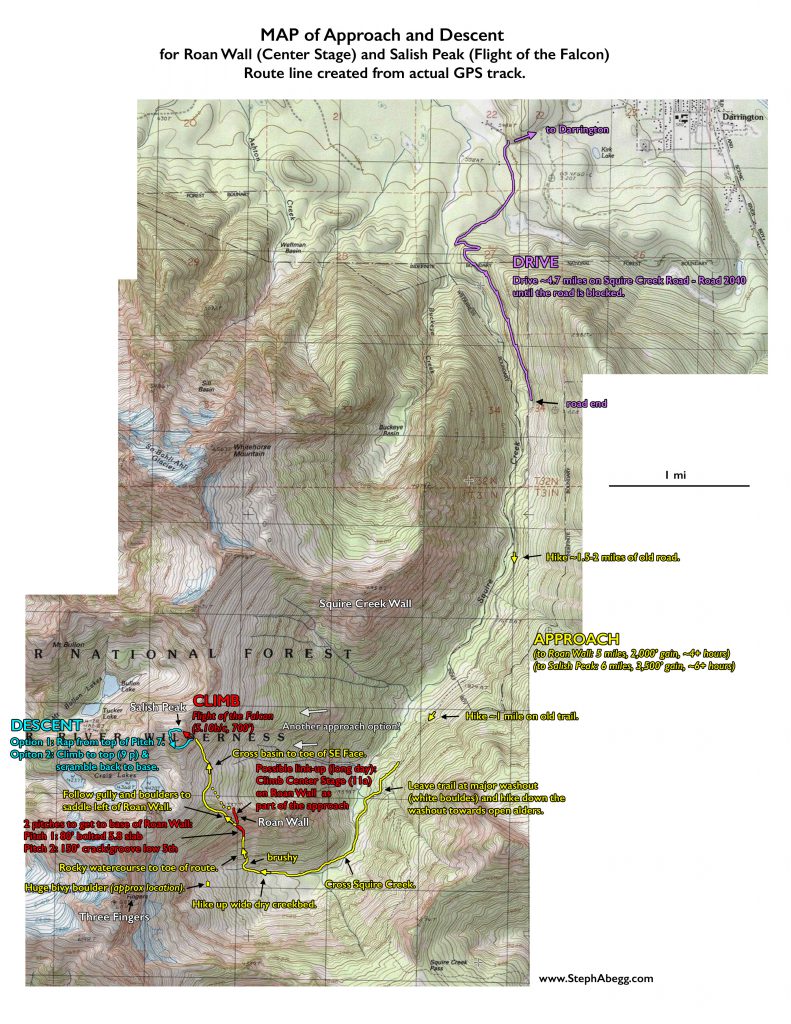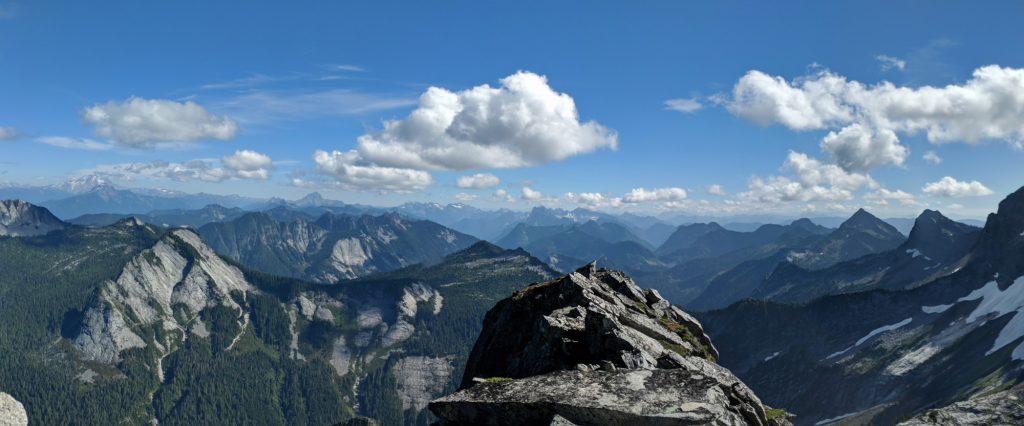Sport/trad route that’s partially bolted and only has 2 ascents on peakbagger?! And it’s an easy walk off. Just a far approach.
Resources
Time
Steph’s times below…
- Car to base of Roan Wall: 4 hours
- Car to base of Salish Peak: 6 hours
- Climb (base to summit): 4 hours, 20 minutes
- Summit to Base: 40 min
- Base to Car: 5 hours, 10 minutes
- Total car-to-car: 4:38am-10:28pm (17 hours, 50 min)
Overview
Flight of the Falcon (10b or 5.9 A0) is a 7-9 pitch, 700-foot route on Salish Peak, a pretty spire located just northeast of Three Fingers. The route starts at the very toe of Salish’s steep south face and climbs high-quality clean granite to the top through a series of ramps, corners, and short steep crux sections. The climbing is mostly sustained at the 5.9ish grade with a few short 5.10 cruxes. The route is very protectable by a mix of gear and bolts (there are 34 protection bolts on the route, by my count), and all of the 5.10 crux face sections are well-protected by bolts; plus, there are bolted belay anchors up to the 7th pitch.
Although this route was established in 2006 (by Chris Greyell and Todd Karner), I first became aware of Flight of the Falcon in 2016 when flipping through Herrington’s recently-published Cascades Rock, a guidebook that has opened up the eyes of the NW climbing community to several awesome 5.10 routes in the Cascades. Herrington calls the route one of the 15 best routes in the Cascades. So obviously I had to do it!
The main obstacle of Flight of the Falcon is a longish approach (it took my partner and me 6 hours from with no route finding errors; and then you have to do this all in reverse at the end of the day). As an indication of the difficulty of the approach, it took me three times and three different partners to finally get through the approach and onto the climb. The first attempt, in July 2016, my partner and I got so soaked by wet brush and intermittent drizzle that we ended up making a fire under the giant bivy boulder below Roan Wall to warm up before hiking out. The second attempt, in August 2017 with a sunny forecast, my partner and I made it to the high basin just below Salish Peak when my partner decided that the rigors of the previous 6 hours had caused her to loose all motivation to do the climb. But at this point I had put in too much work not to actually climb the thing, so just a week later, I was back for my third attempt to climb Flight of the Falcon, this time with Eric Sweet, a Seattle climber who had responded to my mountainproject post looking for a partner for a giant day in the mountains. Despite the discouraging low clouds and cloud drizzle hanging over the mountains as we approached, we pretended to be optimistic about the “clearing by 11am” forecast and squished our way upwards, arriving at the base of a Salish Peak 6 hours after leaving the car. As we had made the final traverse across the high basin towards Salish, as if on cue the wet clouds that enshrouded the mountain began to lift, like a curtain rising at the beginning of a play. Sunbreaks began to dry the rock. We racked up and started upward!
(Note: It is possible to absorb about an hour of this long approach to Salish Peak by climbing Center Stage (11a, 1000′) on Roan Wall to the basin below Salish. However, this would be a very long day.)
Eric and I had a blast. With all of the protection bolts, the climb itself felt very low stress, allowing us to fully enjoy the excellent rock and great position and view. If it wasn’t for the long approach, this climb would be very popular and likely quite crowded, so it was pretty rewarding and cool to be up there on such a high-quality climb that few people had experienced. The following page gives an annotated map of the approach, a route overlay, and photos from the climb. The photos of the approach are a mix of photos I took on my three separate attempts to do this route.

Summit
Views look great!
